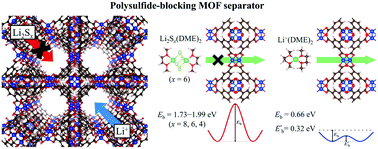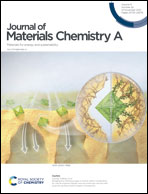The molecular sieving mechanism of a polysulfide-blocking metal–organic framework separator for lithium–sulfur batteries†
Abstract
Development of functional separators that block the migration of lithium polysulfides (LPSs) is an efficient way to suppress the shuttle effect, a critical issue restricting the practical applications of lithium–sulfur (Li–S) batteries. A metal–organic framework (MOF) has been used as a separator for sieving out the LPSs while allowing the Li+ ions to pass through. This study is the first to elucidate the sieving process of the MOF at the atomic level by examining the penetration of Li+ ions and LPSs solvated by 1,2-dimethylethane (DME) molecules into the Cu3(BTC)2 (BTC = benzene-1,3,5-tricarboxylate) MOF nanosheet. The solvated LPSs, i.e., Li2Sx(DME)4 (x = 8, 6, and 4), are too large to enter the pores of the MOF. The partially desolvated LPSs, i.e., Li2Sx(DME)2, can enter the pores but get trapped in the pore walls due to the high penetration barriers of 1.73–1.99 eV. However, the partially desolvated Li+ ions, i.e., Li+(DME)2, can pass through the MOF layer by overcoming a much lower penetration barrier of 0.66 eV without getting trapped in the pore walls. Moreover, Li+(DME)2 can move rapidly within the MOF layer with a very low diffusion barrier of 0.32 eV. The LPS-blocking ability of the MOF results from (1) the steric repulsion between the LPSs and the pore wall due to the pore size not being larger than the size of the LPSs and (2) the formation of chemical bonds between the LPSs and the pore wall due to the solvation structure of the LPSs incompletely surrounded by solvents. The sieving mechanism of the MOF presented in this study will be helpful not only for designing efficient microporous separators for Li–S batteries but also for understanding the transport across general microporous materials.



 Please wait while we load your content...
Please wait while we load your content...